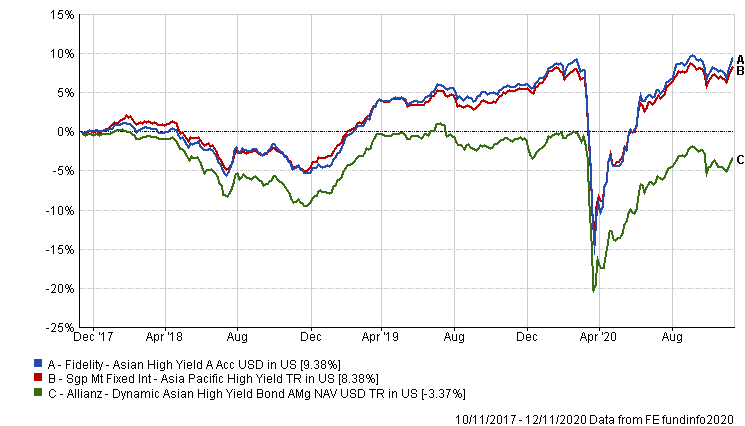The FSA Spy market buzz – 30 May 2025
Korean AI-driven investing, The wisdom of Nvidia, Goldman Sachs and active good news, The sheer size of the top ten, Ferris Bueller and Trump’s tariffs, A trillion here - a trillion there, and much more.

The Allianz fund was doing well before 2018, but after that, it has lagged its peers.
Discreet annual calendar performance (%)
| Fund / index | YTD 2020 | 2019 | 2018 | 2017 | 2016 |
| Allianz GI | -1.63 | 6.35 | -7.47 | 7.61 | 13.22 |
| Fidelity | 2.14 | 11.95 | -4.67 | 6.95 | 13.56 |
| APAC HY peer group* | 1.56 | 10.22 | -3.81 | 7.91 | 6.38 |
“They were really riding on that illiquidity premium, but when they stopped investing in those names, the fund has underperformed, and part of that is due to poor credit selection.
“There has been a consistent theme of some holdings that have defaulted or have been downgraded, so that has been a pretty big drag on their performance,” Ge said.
“I think this points to their smaller investment team, which has four members. Looking at the Asia credits universe, especially within high yield, we think Allianz is a bit stretched and that kind of reflects into their credit selection,” he added.
Meanwhile, the Fidelity fund has consistently outperformed its peers long-term.
“The Fidelity fund’s investment process and credit selection framework has been tested and is also strong, and it has a much larger 10-member team,” Ge said.
Three-year annualised volatility
| Fund / Index | Volatility |
| Allianz GI | 10.71% |
| Fidelity | 9.72% |
| APAC HY peer group* | 9.48% |
 Market volatility is creating enticing opportunities for value investors
Market volatility is creating enticing opportunities for value investors
 The year of living dangerously for income investors
The year of living dangerously for income investors
 Federated Hermes SDG Engagement Equity: 2021 H1 Report
Federated Hermes SDG Engagement Equity: 2021 H1 Report
 Unmasking the dividend opportunity
Unmasking the dividend opportunity
 Conditions in the high yield market
Conditions in the high yield market
 Tech WELLcovered | Work reimagined
Tech WELLcovered | Work reimagined
 Investment Ideas for 2021: Explore the untapped potential in China Small Companies
Investment Ideas for 2021: Explore the untapped potential in China Small Companies
 Who’s afraid of higher interest rates?
Who’s afraid of higher interest rates?
 Despite headwinds, ESG continues to perform
Despite headwinds, ESG continues to perform
 Smartphones on wheels
Smartphones on wheels

Korean AI-driven investing, The wisdom of Nvidia, Goldman Sachs and active good news, The sheer size of the top ten, Ferris Bueller and Trump’s tariffs, A trillion here - a trillion there, and much more.
Part of the Mark Allen Group.
